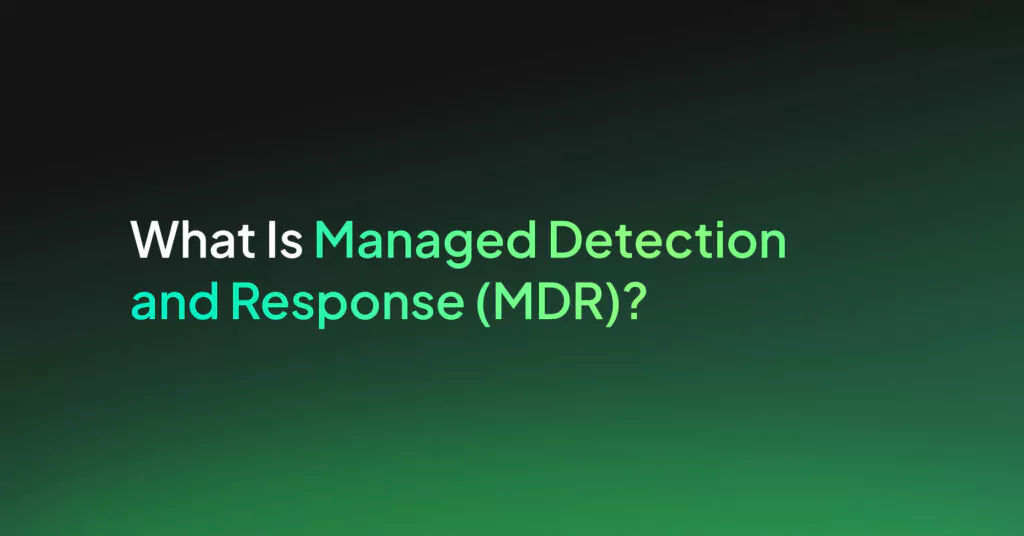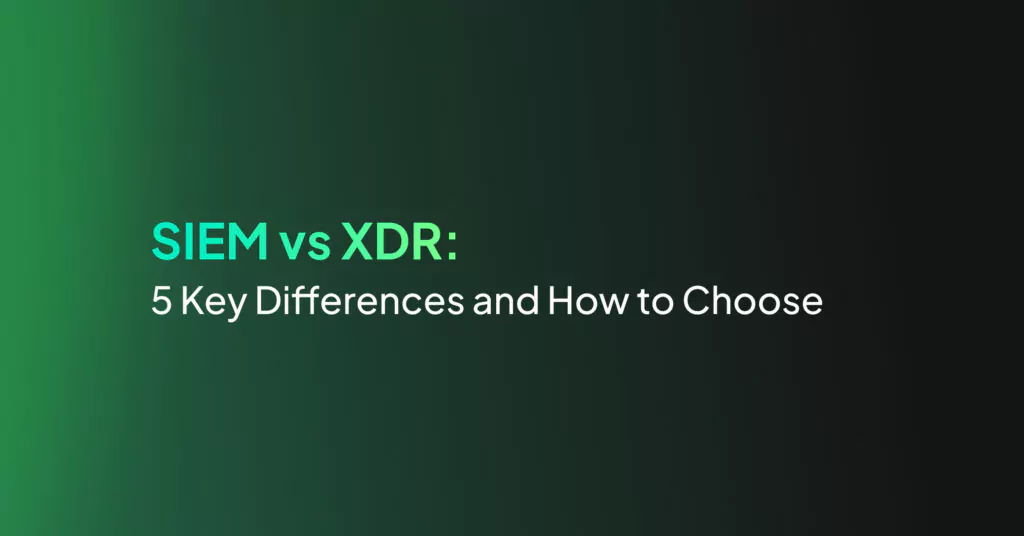What Is Managed Detection and Response (MDR) Security?

7 Benefits of Managed Detection and Response
Managed Detection and Response (MDR) provides numerous advantages for organizations looking to enhance their cybersecurity posture. Below are the key benefits of MDR:
- Proactive Threat Detection and Mitigation: MDR services use continuous monitoring and advanced detection tools to identify threats before they cause significant harm. By leveraging real-time analytics, threat intelligence, and behavioral analysis, MDR ensures proactive detection of both known and unknown threats, reducing dwell time and the potential impact of cyberattacks.
- Faster Incident Response: MDR providers offer rapid response capabilities to contain and remediate threats. With pre-established response playbooks and 24/7 access to security analysts, organizations can address incidents promptly. Rapid response is crucial in containing threats like ransomware or advanced persistent threats (APTs).
- Reduced False Positives: Traditional security systems often generate a high volume of alerts, many of which are false positives. MDR services combine machine learning and human expertise to validate alerts, ensuring that security teams focus only on genuine threats. This reduces alert fatigue and enhances overall operational efficiency.
- Access to Expert Resources: Organizations leveraging MDR gain access to a team of skilled security analysts, threat hunters, and incident responders. This is especially beneficial for smaller teams or businesses lacking in-house expertise, enabling them to benefit from specialized knowledge without the need to build a large security team.
- Cost-Effective Security: For many organizations, maintaining an in-house security operations center (SOC) is prohibitively expensive. MDR provides a cost-effective alternative by offering enterprise-grade threat detection and response capabilities as a managed service. This eliminates the need for expensive infrastructure, tools, and continuous training for internal staff.
- Scalability and Flexibility: MDR services are designed to adapt to the needs of organizations as they grow or as their threat landscape evolves. Whether an organization operates on-premises, in the cloud, or in a hybrid environment, MDR can scale accordingly to provide consistent security coverage.
- Enhanced Business Continuity: By minimizing the likelihood of prolonged disruptions caused by cyberattacks, MDR helps ensure uninterrupted business operations. The ability to quickly detect, contain, and recover from security incidents significantly reduces downtime and data loss.
How Does MDR Cyber Security Work?
MDR cyber security involves continuously monitoring an organization’s IT environment. Security analysts at the MDDR provider use advanced cybersecurity technology. These services typically combine automated detection with human expertise to validate alerts, reducing false positives and ensuring timely action on genuine threats.
One of the key technologies involved in MDR is endpoint detection and response (EDR), which provides visibility into security events on endpoints. EDR systems record behaviors and anomalies, which are then analyzed through automated tools such as machine learning algorithms.
When potential threats are detected, security teams perform further investigation to confirm their validity and prioritize responses. Once verified, they initiate a response plan that could include isolating affected systems, eradicating malicious elements, and restoring normal operations.
MDR services also integrate threat intelligence and forensic data. These tools help security analysts perform threat hunting and analyze complex attack patterns that automated systems might miss.
Once a threat is identified, the MDR team initiates a comprehensive response, which can involve remediation steps like isolating compromised systems, removing malicious code, and restoring systems to their pre-attack state. This combination of detection, investigation, and response helps in minimizing damage and ensuring business continuity.
Related content: Read our guide to real user monitoring
Core Components of Managed Detection and Response
Incident Response
Incident response in MDR focuses on containing and mitigating threats in real time. When a security incident is detected, the MDR team follows predefined response playbooks to limit the impact of the attack. Actions may include isolating infected systems, blocking malicious traffic, and eradicating malware from the environment.
MDR providers also conduct root cause analysis to understand how the incident occurred and to prevent similar future attacks. Additionally, they collaborate with internal teams to restore affected systems and ensure business continuity. This combination of swift action and post-incident analysis helps reduce downtime and strengthen the organization’s defenses against future threats.
Threat Hunting
Threat hunting involves actively searching for hidden threats within an organization’s IT environment. Unlike automated detection systems that react to known attack patterns, threat hunting is a proactive approach led by skilled security analysts. These experts use advanced tools, behavioral analysis, and threat intelligence to identify indicators of compromise (IOCs) and tactics, techniques, and procedures (TTPs) used by attackers.
For example, threat hunters might analyze unusual user behavior, unexpected network traffic patterns, or file modifications to uncover sophisticated attacks, such as advanced persistent threats (APTs). This continuous search for anomalies enhances the organization’s ability to detect and neutralize threats that evade traditional defenses.
Endpoint Detection
Endpoint detection is a critical component of MDR, as endpoints—such as laptops, servers, and mobile devices—are often the primary targets of cyberattacks. MDR services deploy endpoint detection and response (EDR) solutions that monitor endpoint activity for suspicious behavior.
EDR tools collect data on file changes, process executions, network connections, and user behavior, creating a detailed view of endpoint activity. When anomalies are detected, the data is analyzed using machine learning and human expertise to determine whether an attack is underway. This ensures that threats like ransomware or fileless malware are identified and neutralized before they spread across the network.
Threat Intelligence and Analysis
Threat intelligence and analysis involve gathering, contextualizing, and applying information about current and emerging threats. MDR providers leverage global threat intelligence feeds, as well as their own research, to stay updated on the latest attack vectors, vulnerabilities, and adversary tactics.
This intelligence is used to enhance detection capabilities and inform threat-hunting activities. By understanding the methods and motivations of attackers, MDR teams can anticipate threats and develop proactive defense strategies. Threat intelligence also provides context during incident investigations, helping analysts determine the scope and severity of an attack and prioritize remediation efforts effectively.
How Does MDR Compare to Other Managed Security Services?
Here’s a look at how MDR services compare to other managed services offering security capabilities.
MDR vs MSSP
Managed Security Service Providers (MSSPs) primarily focus on monitoring network traffic and alerting clients about potential security incidents. This often leaves the responsibility of incident investigation and response to the client. MSSPs only identify and report issues.
MDR also provides in-depth analysis and executing response actions to mitigate them. MDR providers handle the entire lifecycle of the incident. This includes identifying the threat, analyzing its impact, responding to contain and eliminate it, and providing post-incident analysis to prevent future breaches.
MDR vs EDR
Endpoint Detection and Response (EDR) systems focus on detecting and investigating suspicious activities on individual devices or endpoints. EDR provides useful insights into endpoint security, but it is limited to the devices it protects, and is a technology that needs to be purchased, deployed, and independently managed by the organization.
MDR is a managed service, which typically includes EDR technology, and can be used even by organizations without in-house security expertise. It offers broader security covering entire networks, endpoints, and cloud environments. In addition to EDR capabilities, it provides layers of threat intelligence, expert analysis, and comprehensive incident response. This makes MDR suitable for organizations looking for extensive security coverage and proactive management of cyber threats, beyond just endpoints.
MDR vs SIEM
Security Information and Event Management (SIEM) systems collect and analyze log data from various sources within a network, offering real-time analysis for early threat detection. While SIEM is effective in identifying potential threats through log analysis, it often generates large amounts of data and relies on the organization to respond to incidents.
MDR complements SIEM capabilities by adding a human layer to the monitoring process. MDR teams are responsible for thorough investigative actions and real-time threat response. This ensures swift threat mitigation, reducing the dwell time of potential attackers.
Key Considerations When Choosing an MDR Provider
Selecting an MDR provider requires careful consideration of various factors to ensure that the chosen provider can meet the organization’s security needs and integrate well with existing infrastructure.
1. Expertise and Experience in Cybersecurity
Providers should have a proven track record of handling sophisticated cyber threats and a team of certified security professionals. This ensures that the organization receives the highest level of service and protection against a wide array of potential cyber-attacks.
Additionally, experienced MDR providers bring insights and strategies that can improve an organization’s security posture. Their experts stay current with the evolving threat landscape and continuously improve their techniques to stay ahead of adversaries.
2. Range and Depth of Security Services Offered
MDR services should include continuous monitoring, threat intelligence, incident response, and regular risk assessments. This breadth of services ensures an effective approach to managing and mitigating cybersecurity risks.
Deep service offerings mean that the provider can handle sophisticated and complex threats. They should be able to offer tailored security strategies based on the unique needs and risk profiles of the organization, ensuring protection against both known and emerging threats.
3. Reporting and Transparency
Organizations should choose providers that offer detailed and understandable reports on security incidents, actions taken, and the overall security posture. This helps in maintaining accountability and understanding the value provided by the service.
Transparent reporting also allows organizations to gain insights into their security vulnerabilities and the effectiveness of the measures taken. It enables informed decision-making and continuous improvement of the security infrastructure.
4. Customization and Flexibility in Security Solutions
Providers should offer tailored solutions that meet the requirements of the organization. This ensures that the security measures are aligned with the organization’s specific threat landscape, regulatory requirements, and business objectives.
Flexible services allow organizations to scale and adjust security measures as their needs change. An MDR provider should be adaptable, offering both standardized and custom solutions to address diverse and dynamic security challenges.
Snowbit MDR
Snowbit combines Coralogix’s advanced SIEM with expert-managed security services, creating a unique and cost-effective solution for comprehensive threat protection. Offering proactive, 24/7 monitoring of security events and posture, Snowbit acts as an extension of your security team to not only identify threats and incidents in real time but also resolve them within minutes. With transparent pricing and in-stream data optimization, Snowbit provides unparalleled protection without complexity and is trusted globally to secure cloud environments with speed and precision.





